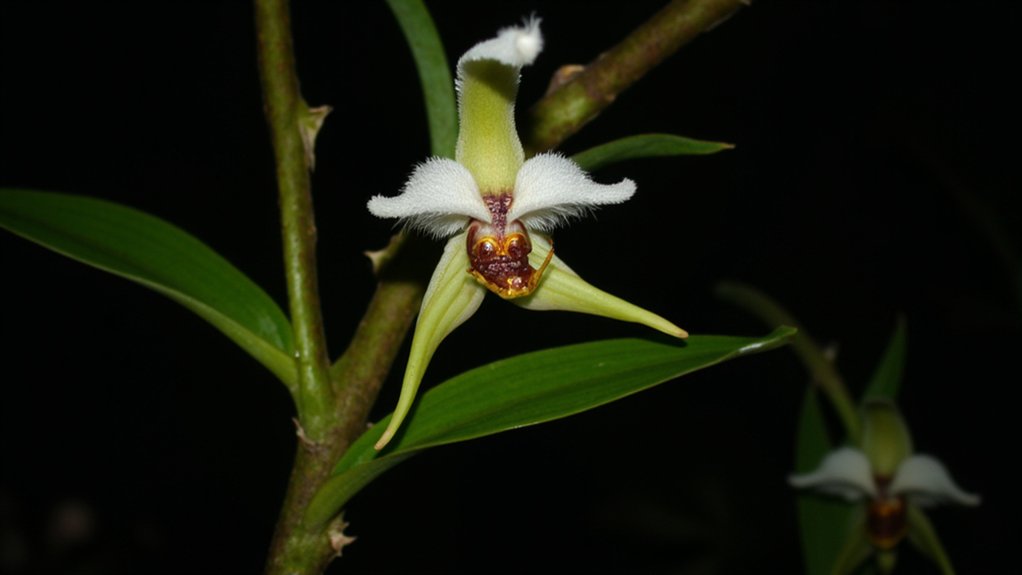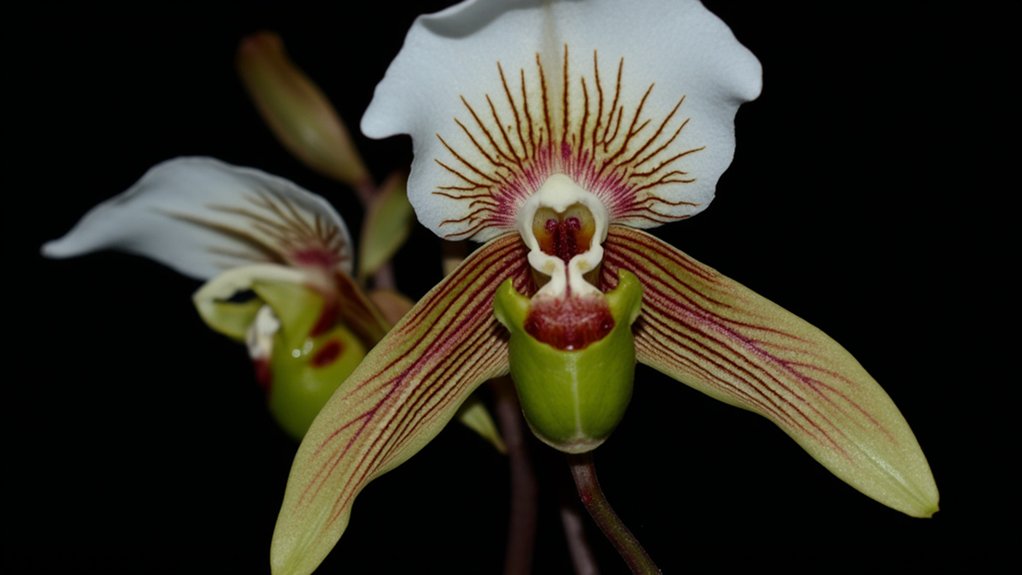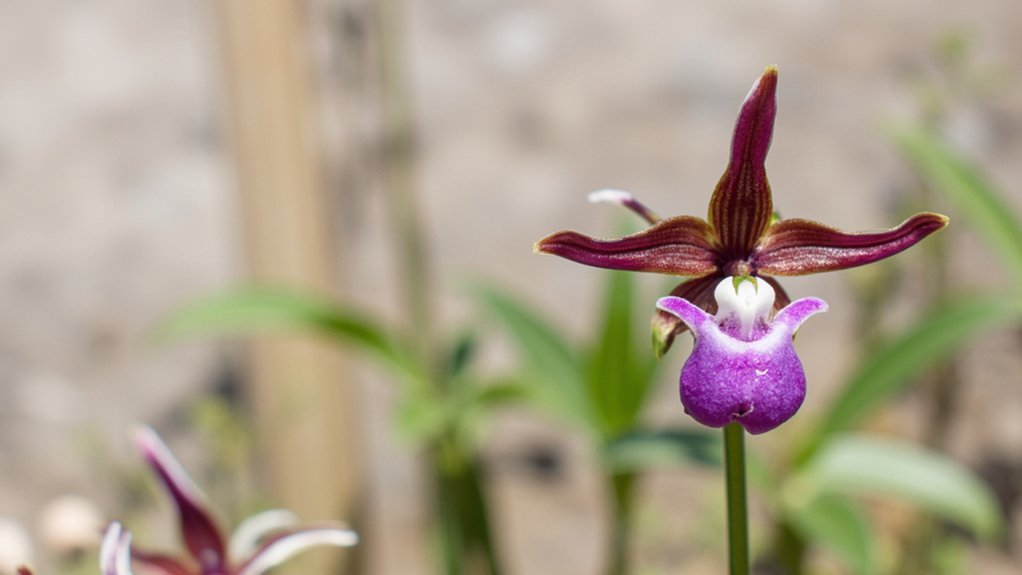While you might spot a monkey swinging through the trees, you’ll be surprised to learn it could actually be an orchid. Nature’s most skilled mimics, plants that resemble animals, have evolved remarkable adaptations over millions of years to fool both predators and pollinators. You’re about to discover how these botanical masters of disguise transform their petals, leaves, and stems into convincing replicas of creatures, from tiny bunnies to graceful birds.
Contents
- 1 The Science Behind Plant Mimicry
- 2 Monkey Face Orchids: Masters of Primate Resemblance
- 3 Flying Duck Orchids: Nature’s Aerial Artists
- 4 Bunny Succulents: Hop Into the World of Monilaria
- 5 White Egret Flowers: Elegant Avian Imitators
- 6 Dove Orchids: Wings of the Plant Kingdom
- 7 Evolution and Survival Through Animal Mimicry
- 8 Growing Your Own Collection of Animal-Like Plants
The Science Behind Plant Mimicry

While many plants rely on bright colors or sweet nectar to attract pollinators, some species have evolved to mimic animals in their appearance. This evolutionary adaptation, known as mimesis, develops over thousands of generations through natural selection, helping plants survive by either attracting or deterring specific creatures.
You’ll find that these plants use various structural modifications to achieve their animal-like appearance. Their leaves, flowers, or seed pods might transform into shapes resembling eyes, faces, or entire bodies. In some cases, they’ll even mimic specific textures, like fur or scales, through specialized tissue arrangements and surface patterns.
Monkey Face Orchids: Masters of Primate Resemblance

Deep within South American cloud forests, the remarkable Dracula simia orchid stands out as nature’s most convincing primate impersonator. You’ll find its furry, reddish-brown center perfectly mimics a monkey’s face, complete with large round eyes and a fuzzy beard-like structure.
The orchid’s distinctive features aren’t random – they’ve evolved over thousands of years. Its center disc measures roughly 2 centimeters across, while the surrounding petals create an elaborate frame that enhances the simian appearance. When you’re examining these rare flowers, you’ll notice they grow upside-down, with their monkey faces dangling at perfect eye level for their pollinators.
Flying Duck Orchids: Nature’s Aerial Artists

The remarkable Flying Duck Orchid (Caleana major) offers another example of nature’s talent for animal mimicry, but this time with an avian twist. You’ll find this unique flower primarily in eastern and southern Australia, where it grows 20-40 cm tall.
When you look closely at the flower’s structure, you’ll see why it earned its name. The labellum (modified petal) resembles a duck in flight, complete with a head, beak, and body. The brownish-purple coloring and distinctive shape aren’t just for show – they help attract male sawfly wasps, the orchid’s primary pollinators.
The flower blooms from September to January, producing just one flower per stem.
Bunny Succulents: Hop Into the World of Monilaria
Among nature’s most endearing succulent species, Monilaria obconica captures hearts with its unmistakable bunny-ear appearance. You’ll recognize these South African natives by their paired leaves that resemble rabbit ears, standing 1-2 inches tall on compact stems.
When you’re growing bunny succulents, they’ll need bright, indirect sunlight and well-draining soil. The distinctive “ears” appear during the plant’s active growing season, typically from late winter to early spring.
These drought-tolerant plants don’t need frequent watering. You’ll want to water them thoroughly but only when the soil is completely dry, roughly every 10-14 days during growing season and less frequently during dormancy.
White Egret Flowers: Elegant Avian Imitators
Moving from rabbit-like succulents to floral bird mimics, nature’s artistic talents shine through in spectacular white egret orchids (Habenaria radiata). Native to China, Korea, and Japan, these rare terrestrial orchids produce delicate white blooms that perfectly mirror the graceful silhouette of egrets in flight.
You’ll find each flower measures roughly 2-3 centimeters across, featuring fringed petals that form distinctive wings, a curved neck, and an elongated head. The plants grow 20-40 centimeters tall in boggy conditions, typically blooming between July and August. Their remarkable bird-like appearance has earned them the nickname “Sagiso” in Japanese culture.
Dove Orchids: Wings of the Plant Kingdom
Spectacular beauty takes flight in dove orchids (Peristeria elata), where pristine white blooms transform into miniature birds perched delicately on emerald stems. You’ll find these remarkable flowers, native to Central and South America, displaying rounded petals that form the body and wings of a dove in flight.
The orchid’s center column perfectly mimics a dove’s head and beak, complete with delicate features that you can observe up close. Each flower measures roughly 1.5 inches across, and you’ll notice they cluster together on stems that can reach up to 3 feet tall.
Grow these beauties in bright, indirect light at 65-80°F, and they’ll reward you with blooms that last 4-6 weeks.
Evolution and Survival Through Animal Mimicry
While survival drives many plant adaptations, animal mimicry stands out as one of nature’s most fascinating evolutionary strategies. You’ll find this clever defense mechanism has developed over millions of years, helping plants avoid predation through deceptive appearances.
When you examine these mimics closely, you’ll notice how they’ve evolved specific features that fool their enemies. Some orchids, like Ophrys apifera, display patterns that look exactly like female bees, while others mimic caterpillars or butterflies.
This remarkable adaptation isn’t just about looks – it’s about survival. These plants have developed complex structures that trick insects into pollinating them, ensuring their species’ continuation.
Growing Your Own Collection of Animal-Like Plants
Once you’ve identified which animal-like plants capture your interest, you’ll need to understand their specific growing requirements before starting your collection. Most animal-mimicking species thrive in tropical or subtropical conditions, requiring temperatures between 65-85°F and humidity levels above 60%.
Start with easier varieties like the bird’s nest fern or rabbit succulent. You’ll want to place them in well-draining potting mix and provide indirect sunlight for 6-8 hours daily. Monitor soil moisture with a moisture meter, keeping it consistently damp but never waterlogged.
For advanced growers, try the monkey face orchid or duck orchid, which need specialized care and precise environmental controls.
